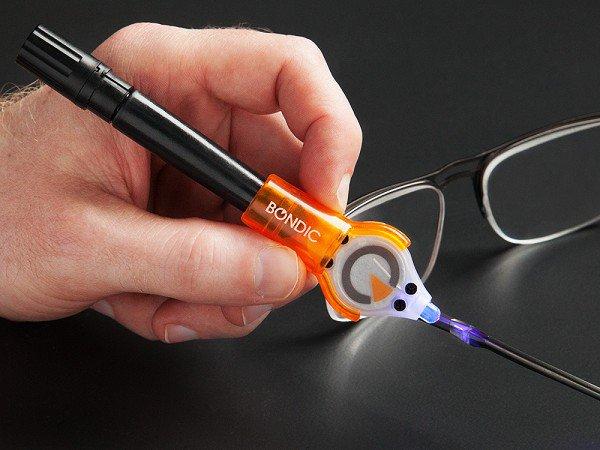If you haven’t seen Bondic, a unique liquid plastic welder or, as they’re marketing themselves of late, the world’s first 3D pocket printer (which is beyond a stretch), it’s a nifty little tool about the size of a pen that basically holds a small tube of bonding material with a pen tip dispenser at one end and a special UV light at the other.
To make a repair, you simply rough or score the materials to be repaired, lay down a thin bead of Bondic’s non-hardening resin, and, when everything’s in place just right, shine the included UV light on the spot for about five seconds. Almost instantly, you’ve got a hardened plastic that, depending on what you’re repairing, appears to us to be pretty solid.
Bondic can be used to repair many [mostly small] items—things that you’d probably turn to a super glue for to repair, or perhaps hesitantly consider using super glue to repair because you aren’t aware of any alternatives. But super glues are super sticky, super stinky, and cure super fast in most cases, especially when fixing smaller items. And unlike most superglues, Bondic can be used as a filler—even replacing missing material—and then sanded, filed, painted, drilled, or tapped, if so desired.
Here’s a short video showing Bondic at work:
While we here at GarageSpot haven’t conducted a complete Hands-On write-up of the Bondic tool, there are a ton of video reviews of Bondic floating around out there—some fair, some not so much—so we’ll just point you to those instead.
Is Bondic worth the $20 + about $10 per refill? We’d say yes, even just to have around the shop for those stubborn chips, cracks, and repairs where glue just never works very well. You can buy Bondic here!.







![Best Tire Changers for Amateurs and Professionals [2022 Review]](https://garagespot.com/wp-content/uploads/2022/01/Best-tire-changer-e1652905942544-compress-211x150.jpg)
Tried this to repair a tie down tab in the back of our SUV. The original piece is ABS plastic. I sanded it all around and used two entire tubes of Bondic but it didn’t hold. I guess I could have used 10 tubes of the stuff and just surrounded the broken plastic. Not sure what I did wrong, but it was $30 down the drain. May be useful for smaller parts.